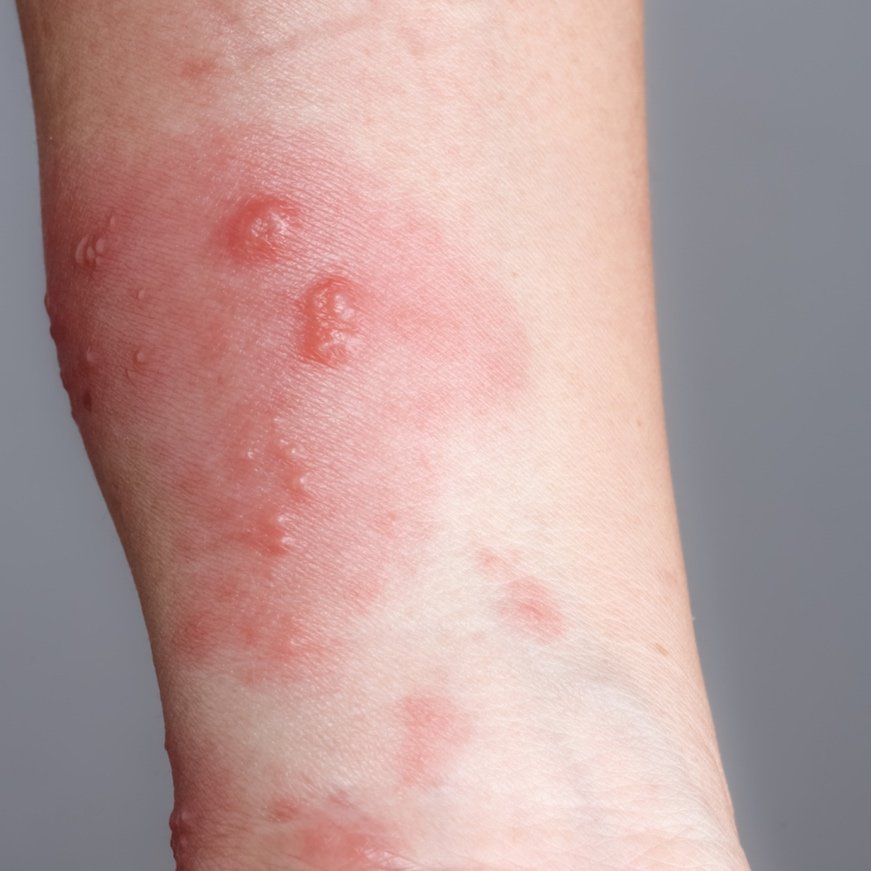Poison Ivy: an overview
If you’ve ever had poison ivy, you’ll know it is intensely itchy (and annoying!)
This article goes over how to identify poison ivy, tips and tricks to manage it, how to prevent it, and when to call the doctor.
What it is:
Rhus dermatitis is the name given to the allergic reaction triggered by plants such as poison ivy, oak, and sumac.
In about 80% of people, an exposure to plants will cause an intensely itchy rash - and we see it more in the summertime, when we’re all spending more time outdoors.
Symptoms
Within 1-4 days after exposure, you will see red bumps that eventually becomes fluid-filled blisters.
Over the next few days, the blisters ooze and crust over.
They are typically in a line, but can also be seen in clusters depending on where the skin was exposed.
It is also possible to see some swelling in the area, especially if the exposure is on the face or the genitals.
The rash can be present for up to 1-3 weeks.
The Pediatrician Mom Tip: You can also see the rash crop up over different areas at different times, especially if there is still oil from the initial exposure remaining under fingernails.
“Black Spot” Poison Ivy is a rare subtype of poison ivy caused by remnants of black oxidized Uroshiol (the triggering oil).
Why does it happen?
The triggering element is actually an oily resin (Uroshiol), which is present in every element of these plants (fruit, leaves, stems, root).
When your body is exposed to the oil, it develops a Type IV (or “delayed type”) hypersensitivity reaction.
Note that the oil can linger on surfaces for a long time, so if you touch clothes that brushed up against the plant, or gardening tools that have not been washed, you can still get the rash.
Poison ivy can also be inhaled if it is burned and can cause airway issues.
The Pediatrician Mom Tip: Contrary to popular belief, the fluid from the blisters is not contagious.
What can you do?
None of these interventions will decrease how long the rash is present - unfortunately, the only way to handle poison ivy is to address symptoms and prevent secondary bacterial infections. It is all supportive care.
Wash off the oil from the skin and under the fingernails as soon as possible (ideally within 1 hour).
Use warm running water and soap (such as dishwashing liquid) for at least 5-10 minutes.
Alcohol-based wipes can also be used if you are out.
Make sure you wipe in one direction rather than scrubbing/rubbing back and forth to minimize irritation and trauma to the skin.
Keep your child comfortable:
Cool wet compresses can soothe the skin
Colloidal oatmeal baths or baking soda paste can help with itching.
Topical creams or ointments that contain menthol or phenol (calamine) 3 times per day as needed. Do not apply to face or genitals.
For blisters:
Domeboro (which contains aluminum acetate) can help dry up blisters.
Minimize scratching:
Minimize further trauma to the skin. Keep nails short!
Topical hydrocortisone (1%) can also help.
The Pediatrician Mom Tip: No benefit has been shown with topical anesthetics (eg. benzocaine), topical benadryl, topical antibiotics such as bacitracin or oral antihistamines (eg. Zyrtec).
When to call the pediatrician
This is not a comprehensive list. In general, always err on the side of calling your pediatrician if you have any concerns about your child. There is a lot to be said for a parent’s gut instinct, and I promise: your pediatrician would rather you called!
If your child is not improving within a few days, or if they seem to be getting worse, call your pediatrician. Other concerning symptoms include:
Severe widespread rash over more than 25% of skin surface
Rash in delicate areas (face, genitals)
Very uncomfortable
The rash is not improving (or is getting worse)
Signs of a skin infection (eg. increased redness, swelling, pus, warmth, or more systemic symptoms such as fever or vomiting).
If you think your child inhaled smoke from a burning poison ivy plant.
Prevention
There are several things you can do to help protect your child from poison ivy.
PC: Canva
Teach them what it looks like (and make sure you know too). “Leaves of 3, let it be” is a common saying that is easy to remember. Here is a good video that reviews how to identify poison ivy, oak and sumac.
Wash clothing, shoes, gardening tools, and camping equipment that may have contacted poison ivy with hot soapy water. It can linger on surfaces for a long time!
Wear long sleeves, pants, socks and shoes if you are somewhere you might be exposed. If you are gardening, remember even dead plants can cause the rash. Wear gloves.
Wash pets with shampoo if they’ve been exposed.
FAQs
What about oral steroids?
In very rare circumstances, oral steroids or injections may be prescribed for 14-21 days, but these are rarely necessary.
Is my child contagious? Can they return to school?
The rash is not contagious. But it CAN spread if there is lingering oil underneath fingernails or on surfaces. It is fine to return to school.
Is it possible to be immune to poison ivy?
Yes! About 15-20% of people have no reaction. Unfortunately, repeated exposure does not increase likelihood of becoming immune (in fact, it can do the opposite and make your reaction worse).
Hopefully this article covers everything a parent needs to know to effectively tackle this summertime annoyance!
As always, call your pediatrician if you’re concerned!






